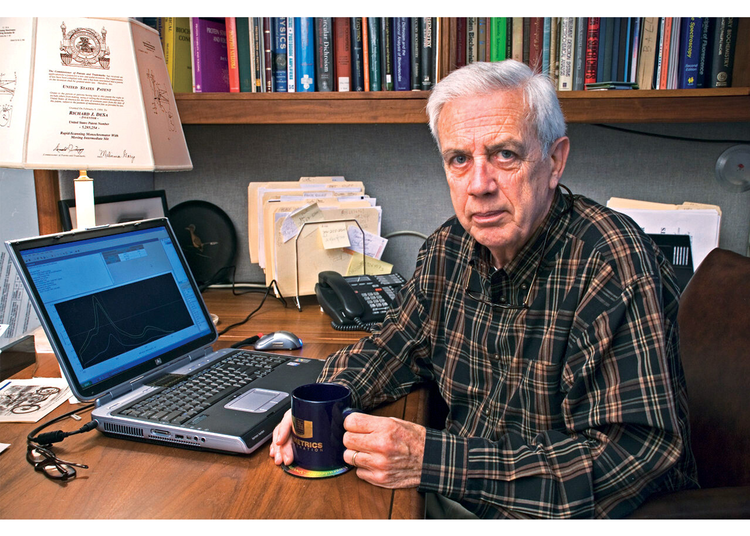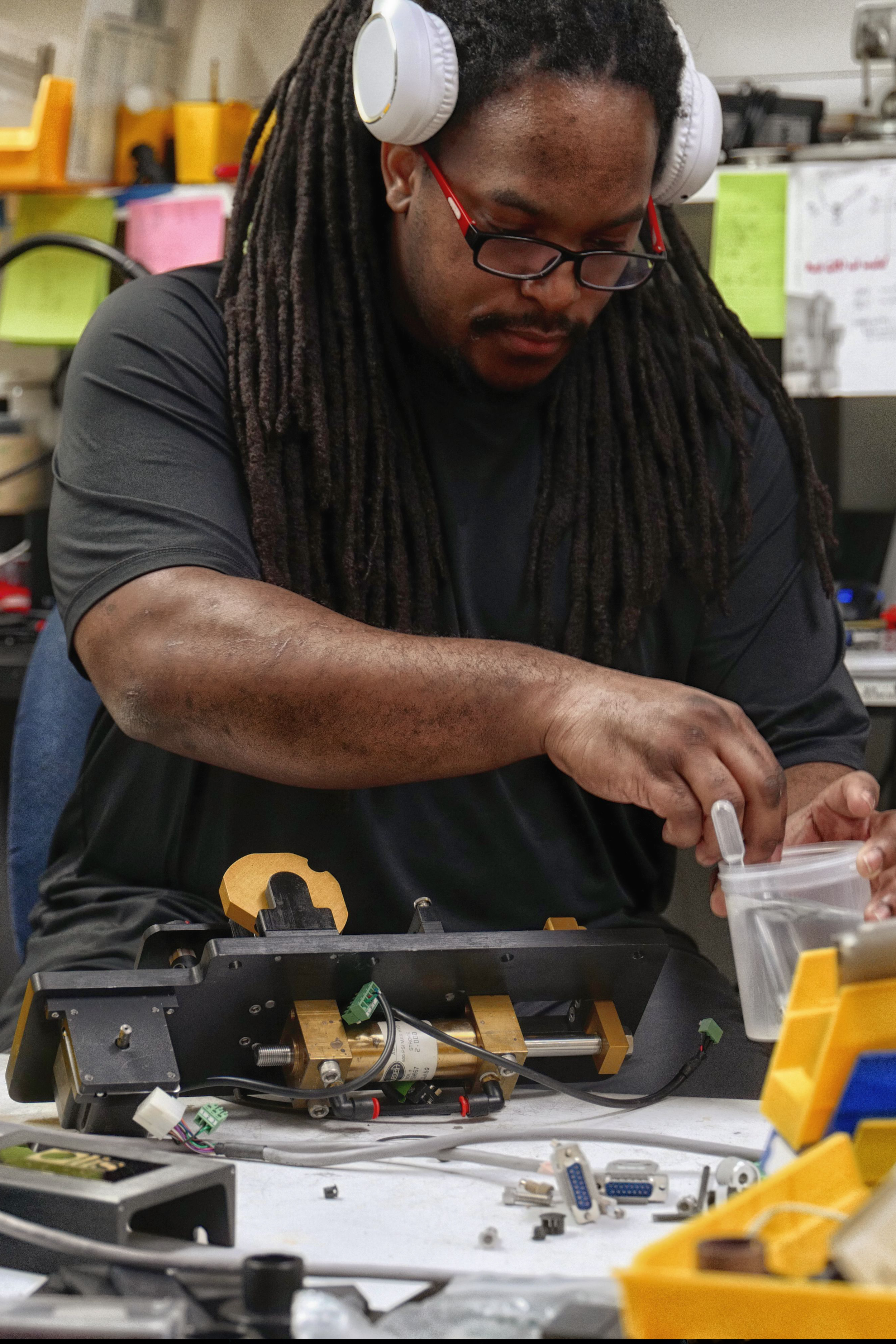10 Simple Techniques For Uv/vis
10 Simple Techniques For Uv/vis
Blog Article
An Unbiased View of Circular Dichroism
Table of ContentsThe Main Principles Of Uv/vis/nir Top Guidelines Of Circularly Polarized LuminescenceThings about Circularly Polarized LuminescenceLittle Known Facts About Spectrophotometers.5 Easy Facts About Circular Dichroism ShownWhat Does Uv/vis Mean?Spectrophotometers for BeginnersWhat Does Spectrophotometers Do?The Definitive Guide to SpectrophotometersNot known Facts About Spectrophotometers8 Simple Techniques For Uv/vis/nirLittle Known Questions About Uv/vis/nir.The Buzz on Uv/vis
It is then scanned through the sample and the reference options. Fractions of the incident wavelengths are sent through, or reflected from, the sample and the recommendation. The resultant light strikes the photodetector device, which compares the relative intensity of the two beams. Electronic circuits transform the relative currents into direct transmission portions and/or absorbance/concentration values.The transmission of a referral compound is set as a standard (datum) worth, so the transmission of all other substances are recorded relative to the initial "zeroed" compound. The spectrophotometer then converts the transmission ratio into 'absorbency', the concentration of particular components of the test sample relative to the preliminary compound.
Because samples in these applications are not easily available in large amounts, they are particularly matched to being analyzed in this non-destructive method. In addition, valuable sample can be saved by using a micro-volume platform where as little as 1u, L of sample is required for complete analyses. A quick explanation of the procedure of spectrophotometry consists of comparing the absorbency of a blank sample that does not contain a colored compound to a sample which contains a colored substance.
About Circular Dichroism
In biochemical experiments, a chemical and/or physical property is picked and the procedure that is used is particular to that residential or commercial property in order to derive more information about the sample, such as the quantity, pureness, enzyme activity, and so on. Spectrophotometry can be used for a number of methods such as identifying optimum wavelength absorbance of samples, identifying optimum p, H for absorbance of samples, determining concentrations of unidentified samples, and determining the p, Ka of numerous samples.: 21119 Spectrophotometry is also a valuable procedure for protein purification and can also be utilized as a technique to develop optical assays of a compound.
It is possible to understand the concentrations of a 2 component mix using the absorption spectra of the standard options of each component. To do this, it is needed to understand the extinction coefficient of this mixture at 2 wave lengths and the termination coefficients of solutions that consist of the recognized weights of the 2 components.

Unknown Facts About Uv/vis/nir
The majority of spectrophotometers are used in the UV and visible regions of the spectrum, and a few of these instruments also run into the near-infrared region as well. The concentration of a protein can be estimated by measuring the OD at 280 nm due to the existence of tryptophan, tyrosine and phenylalanine (https://www.pearltrees.com/olisclarity1#item574664694).
This technique requires a spectrophotometer capable of determining in the UV area with quartz cuvettes.: 135 Ultraviolet-visible (UV-vis) spectroscopy includes energy levels that delight electronic transitions. Absorption of UV-vis light excites particles that are in ground-states to their excited-states.
These curves can be used to test a new batch of colorant to examine if it makes a match to specs, e
Traditional visible region spectrophotometers can not detect if spot colorant or the base material has fluorescence. This can make it tough to handle color concerns if for example one or more of the printing inks is fluorescent. There are two major setups for visual spectrum spectrophotometers, d/8 (spherical) and 0/45.
Researchers use this instrument to measure the amount of substances in a sample. If the compound is more concentrated more light will be soaked up by the sample; within little varieties, the Beer, Lambert law holds and the absorbance between samples vary with concentration linearly. When it comes to printing measurements 2 alternative settings are typically used- without/with uv filter to control better the result of uv brighteners within the paper stock.
Not known Incorrect Statements About Spectrophotometers
Some applications need small volume measurements which can be carried out with micro-volume platforms. As explained in the applications area, spectrophotometry can be utilized in both qualitative and quantitative analysis of DNA, RNA, and proteins. Qualitative analysis can be utilized and spectrophotometers are utilized to tape spectra of compounds by scanning broad wavelength regions to determine the absorbance homes (the intensity of the color) of the compound at each wavelength.

All About Circularly Polarized Luminescence
One major element is the kind of photosensors that are available for different spectral regions, but infrared measurement is also challenging due to the fact that essentially whatever emits IR as thermal radiation, specifically at wavelengths beyond about 5 m. Another issue is that several materials such as glass and plastic take in infrared, making it incompatible as an optical medium.
Samples for IR spectrophotometry may be smeared between 2 discs of potassium bromide or ground with potassium bromide and pushed into a pellet. Where aqueous solutions are to be measured, insoluble silver chloride is utilized to build the cell. Spectroradiometers, which operate almost like the visible area spectrophotometers, are created to determine the spectral density of illuminants. 2013. p. 13. Allen, DW; Cooksey, C; Tsai, BK (Nov 13, 2009). "Spectrophotometry". Recovered Dec 23, 2018. Ninfa AJ, Ballou DP, Benore M (2010 ). Essential Laboratory Methods for Biochemistry and Biotechnology (2nd ed.). Hoboken: Wiley & Sons. ISBN 9780470087664. OCLC 488246403. Schwedt G (1997 ). The vital guide to analytical chemistry.
Oke, J. B.; Gunn, J. E.
An Unbiased View of Uv/vis/nir

1021/ac50048a728. ISSN0003-2700. Ninfa AJ, Ballou DP, Benore M (2015 ). Basic Lab Techniques for Biochemistry and Biotechnology (3, rev. ed.). Hoboken, NJ: Wiley & Sons. p. 77. ISBN9780470924525. OCLC915641828. "Totally Automatic Double Beam - Atomic Absorption Spectrophotometer (AA 8000)". Lab Devices. Labindia Analytical Instruments Pvt. Ltd. "Spectrophotometry Applications and Principles".
Our Uv/vis Diaries
"Applied Spectrophotometry: Analysis of a Biochemical Mixture". Biochemistry and Molecular Biology Education. Journal of Biochemistry Education.
The Best Strategy To Use For Circularly Polarized Luminescence
U.S. Department of Commerce National Bureau of Standards unique publication; 378. Washington, D.C.: U.S. National Bureau of Standards.
The process begins with a regulated source of light that lights up the evaluated sample. In the case of reflection, as this light communicates with the sample, some is taken in or emitted. The produced light travels to the detector, which is analyzed, measured, and provided as industry-standard color scales and indices.
Market governing bodies usually specify particular metrics for specific items, such as Tomato and Coffee indices. The streamlined mathematics appears like this: Where R is the reflection coefficient. All terms are assessed over the visible spectrum from 400 to 700 nm. In the case of transmission, when the light communicates with the sample, it is either absorbed, shown, or transmitted.
Facts About Circularly Polarized Luminescence Revealed
Examples include APHA (American Public Health Association) for watercolor and purity analysis, ASTM D1500 for petrochemical color analysis, edible oil indices used in food, and color analyses of beverages. The streamlined mathematics appears like this:. Where T is the transmission coefficient. All terms are examined over the noticeable spectrum from 400 to 700 nm.
Image Credit: Matej Kastelic/ Dr. Arnold J. Beckman and his coworkers at the National Technologies Laboratories initially created the spectrophotometer in 1940. In 1935 Beckman founded the company, and the discovery of the spectrophotometer was their most ground-breaking invention. Dr. Bruce Merrifield, a Nobel prize-winning biochemist, stated that the invention of the spectrophotometer was "probably the most crucial instrument ever established towards the development of bioscience." Before the discovery of the spectrophotometer, chemical analyses took weeks to complete, with 25% accuracy.
Indicators on Spectrophotometers You Need To Know
Over time, researchers kept improving the spectrophotometer style to improve its efficiency. The UV capabilities of the design B spectrophotometer were improved by changing the glass prism with a quartz prism.
Generally, a spectrophotometer is made up of 2 instruments, particularly, a spectrometer and a photometer. A basic spectrophotometer contains a light source, a monochromator, a collimator for straight light beam transmission, a cuvette to place a sample, and a photoelectric detector.
Uv/vis/nir for Beginners
There are different kinds of spectrophotometers in different shapes and sizes, each with its own function or performance. A spectrophotometer determines how much light is shown by chemical elements. circularly polarized luminescence. It measures the difference in light intensity based upon the overall amount of light presented to a sample and the quantity of beam that passes through the sample solution
A spectrophotometer is used to determine the concentration of both colorless and colored solutes in an option. This instrument is utilized to figure out the rate of a reaction.
Report this page